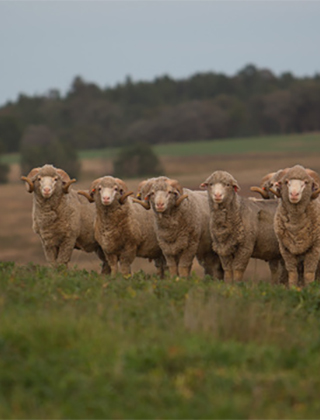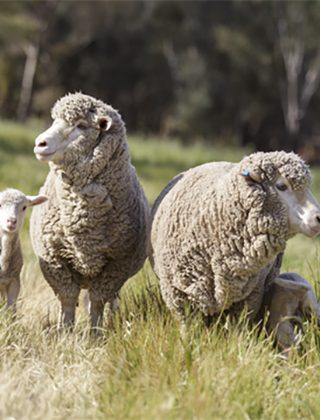Pregnancy scanning – an ‘ultra sound’ investment averaging $5.75/ewe profit
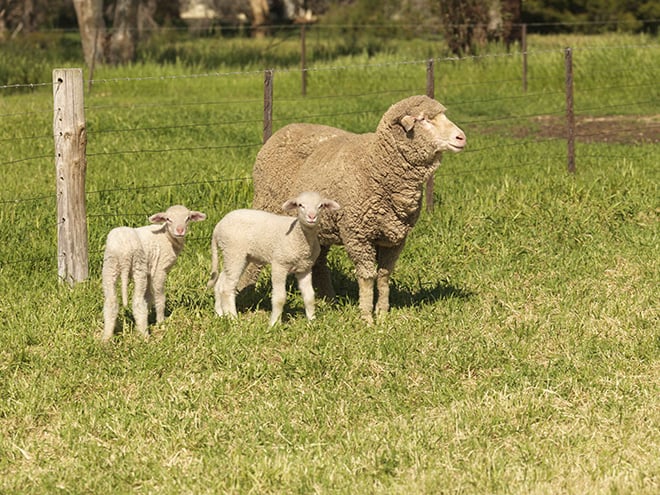
Major new research shows that pregnancy scanning has a high return on expenditure for sheep producers, with scanning for multiples increasing potential profit by an average of $5.75/ewe scanned, across 27 scenarios that the researchers examined for winter rainfall areas. Scanning for multiples provided twice the value of scanning for only pregnancy status.
Pregnancy scanning can be used to identify the litter size of pregnant ewes, thereby enabling optimised nutrition and lambing management of each group, which increases marking rates and farm profit.
Major new research shows that pregnancy scanning has a high return on expenditure for sheep producers, with scanning for multiples increasing potential profit by an average of $5.75/ewe scanned, across 27 scenarios that the researchers examined for winter rainfall areas. Scanning for multiples provided twice the value of scanning for only pregnancy status.
Summary of research results
- Pregnancy scanning is low-cost with a high return on expenditure.
- Scanning for multiples increased profit in all winter rainfall scenarios tested, by an average of $5.75/ewe scanned ranging from $1.20 to $11.50.
- Average return on investment was 400%
- Profit for the examined summer rainfall region increased by an average of $4.44/ewe scanned.
- Scanning for multiples was twice the value of scanning for only pregnancy status (ie wet/dry) for the average flock.
- Scanning for only pregnancy status was profitable in most scenarios.
- Capturing the potential profit requires implementing some management changes to utilise the information provided from scanning – see below.
Actions to take following scanning
- Remove empty ewes from the breeding flock – if the flock can ‘self-replace’, then sell once-dry; otherwise, sell twice-dry. Consider the best time to sell (eg at scanning or following shearing).
- Allocate feed in favour of multiple-bearing rather than single-bearing ewes and especially empty ewes.
- Allocate better lambing paddocks to multiple-bearing ewes.
- Reduce mob size for multiple-bearing ewes.
- Keep the singles and the multiple born lambs separate when you're selecting your replacement ewes.
- Other benefits/actions include: the ability to prepare the lambing feed budget in advance, early detection of any reproductive failure, and the ability to more rapidly re-mate empty ewes.
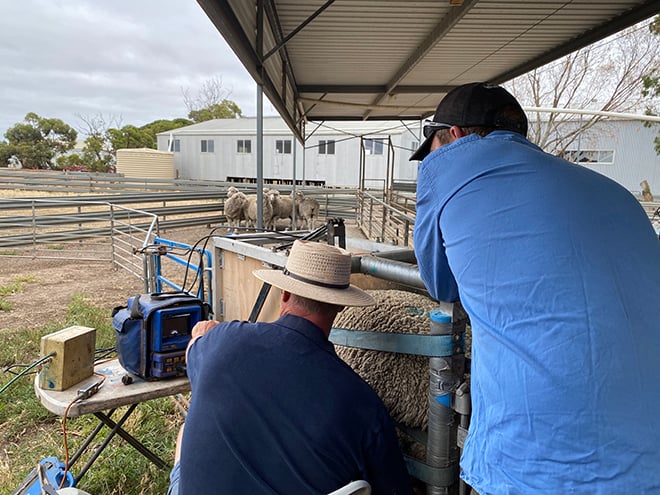
Pregnancy scanning conducted by a trained contractor with specialised equipment. PHOTO: Cousins Merino Services
The results of new research funded by AWI and Meat & Livestock Australia (MLA) clearly show the value of pregnancy scanning for increased farm profitability. The main benefit of scanning is that it enables sheep producers to better meet the nutritional requirements of ewes of different litter sizes, including empty ewes, thereby increasing marking rates.
“Pregnancy scanning is a valuable tool for increasing reproductive efficiency and farm profitability but it has not been widely adopted. The 2021 AWI/MLA National Producer Survey revealed that 58% of producers do not scan their ewes and past research has indicated that the main reason for this is that they ‘see no benefit’,” said AWI Project Manager, Reproduction & Nutrition, Emmah Goldsmith.
“The outcomes of this project have proven that there is, in fact, a strong economic benefit of scanning. It is hoped that the communication of these results will drive up adoption of pregnancy scanning and lead to increases in lamb survival and weaning rates.”
The research project began in 2019 and was led by Associate Professor Forbes Brien of The University of Adelaide.
“The research involved an extensive benefit-cost analysis of the value of scanning across a range of sheep producing regions and enterprise types,” Dr Brien said.
“It has resulted in a detailed and strong rationale for pregnancy scanning: profitable across all regions in the winter and summer rainfall regions of southern Australia, across all genotypes, and for all times of lambing that we examined.
“With a return on investment of 400% for sheep producers, pregnancy scanning for multiples can and should be a vital tool for improving reproductive rate, and lamb and ewe survival rates.”
Broad research parameters
The comprehensive economic analysis of the on-farm benefit of pregnancy scanning was undertaken for a range of regions, genotypes and times of lambing.
The analysis was carried out for three winter rainfall regions with varying length growing seasons:
- Long growing season based on the Hamilton area in south-west Victoria
- Medium growing season based on the Darkan area in the Great Southern of WA; and
- Short growing season based on the Cunderdin area in central wheat belt of WA.
Analysis was also carried out for a summer rainfall region, the Northern Tablelands of NSW that is dominated by Merino fine wool production.
For each region, three lambing times (autumn, winter, spring) and three breed types were evaluated:
- Merino – a self-replacing Merino flock with emphasis on wool production.
- Merino-Terminal Sire – a self-replacing Merino flock utilising surplus ewes for first-cross lamb production. The emphasis is on meat and wool production.
- Maternal – composite ewes are mated to composite rams to produce composite lambs. The emphasis is on meat production.
The cost of scanning represented in the analysis included both the cost of the contractor and the labour cost associated with pushing the ewes through the scanning crate and the mustering that is required per mob. The value of scanning was calculated by comparing farm profit if the flock was not scanned with a flock that was scanned. The comparison was carried out for flocks that were scanned for multiples or only for pregnancy status.
The management changes that were undertaken knowing the result of the pregnancy scanning included (a) implementing optimal management of the empty ewes, (b) optimising pregnant ewe nutrition by separating single and multiple bearing ewes and feeding according to their different needs, and (c) optimal allocation of the lambing paddocks based on litter size.
Research results
Scanning for multiples
Table 1 shows that utilising the information from pregnancy scanning for multiples increased profitability for all 27 winter rainfall scenarios.
Based on long-term prices for the period 2004 to 2020, the profit averaged $5.75 per ewe scanned, and ranged from $1.20 up to $10.60 per ewe. For a 2,000 head ewe flock, this is a profit of $11,500.
This equates to a 400% return on the scanning investment.
These results alone indicate that pregnancy scanning is likely to increase profitability for the majority of farmers.
The value of scanning was higher for flocks that were lambing in autumn and slightly less for flocks lambing in spring. This difference in value associated with time of lambing is because the early lambing flocks are scanning and identifying the empty ewes prior to the main feed shortage, which increases the value of adjusting their nutritional management or from selling at scanning.
Scanning for multiples increases profitability more for Merino flocks than maternal flocks because preferential nutrition and preferential allocation of sheltered paddocks has a greater effect on the survival and production of multiple-born Merino lambs.
For the summer rainfall region, the average profit was $4.44/ewe scanned.
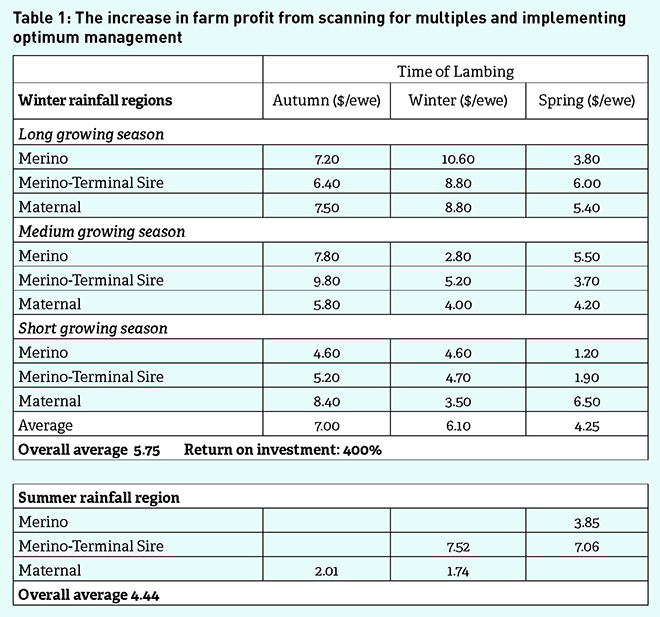
Scanning for only pregnancy status
In most (but not all) scenarios examined, scanning for only pregnancy status (ie wet/dry) was also profitable. However, it was almost always less profitable than scanning for multiples. Across the winter and summer rainfall regions, scanning for pregnancy status was only half as valuable as scanning for multiples.
These results suggest that scanning for only pregnancy status is a good starting point for farmers who are gaining experience with scanning, but that it should be used as a stepping stone to scanning for multiples.
(The results of the recent AWI/MLA producer survey showed that, where producers did pregnancy scan in 2021, 31% of producers scanned only for pregnancy status, while 69% scanned for multiples.)
Other analysis
The biggest single contributor to profitability was selling the dry/non-pregnant ewes to increase subsequent reproduction in the flock (see Table 2). The other management components each made a similar contribution to the total value of scanning.
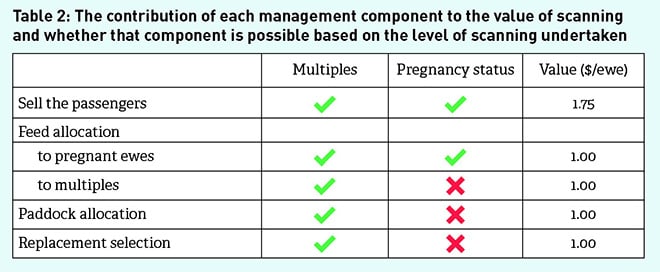
The profitability of scanning is sensitive to sheep meat prices, but not very sensitive to wool and grain supplement prices, nor overall reproductive rate of the flock.
Accuracy of scanning
The research team has been working actively with pregnancy scanners to better understand the accuracy of pregnancy scanning, improve their skills base, and to encourage the trialling and adoption of innovations in scanning technology.
Accuracy of scanning can be improved by scanning at the correct time – scan for multiples (litter size) 80-90 days after the rams go in (based on the industry recommended 5-week joining period) and by correct preparation of the ewes on the day of scanning – ewes should be off feed and water overnight prior to scanning.
More information: The project team is creating extension materials (eg fact sheets, and training resources for scanners) which will be available for sheep producers next year.
This article appeared in the December 2022 edition of AWI’s Beyond the Bale magazine. Reproduction of the article is encouraged.







